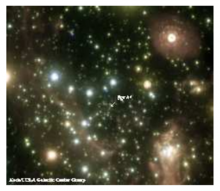
Abstract
As the closest example of a galactic nucleus, the Galactic center presents an exquisite laboratory for learning about supermassive black holes (SMBH) and their environs. Detailed studies of stellar dynamics deep in the potential well of a galaxy, with exisiting and future large ground-based telescopes, offer several exciting directions in the coming decade. First, it will be possible to obtain precision measurements of the Galaxy's central potential, providing both a unique test of General Relativity (GR) and a detection of the extended dark matter distribution that is predicted to exist around the SMBH. Tests of gravity have not previously been possible on the mass scale of a SMBH. Similarly, only upper limits on the extended matter distribution on small scales currently exist; detection of dark matter on these scales is an important test of Lambda-CDM and the detection of stellar remnants would reveal a population that may dominate the stellar dynamics on the smallest scales. Second, our detailed view of the SMBH and its local gas and stellar environment provides insight into how SMBHs at the centers of galaxies form, grow and interact with their environs as well as on the exotic processes at work in the densest stellar clusters in the Universe. The key questions, still unanswered, of when and how SMBHs formed in the early universe, and the myriad ways in which feedback from SMBHs can affect structure formation, can be informed by directly observing the physical processes operating at the SMBH.